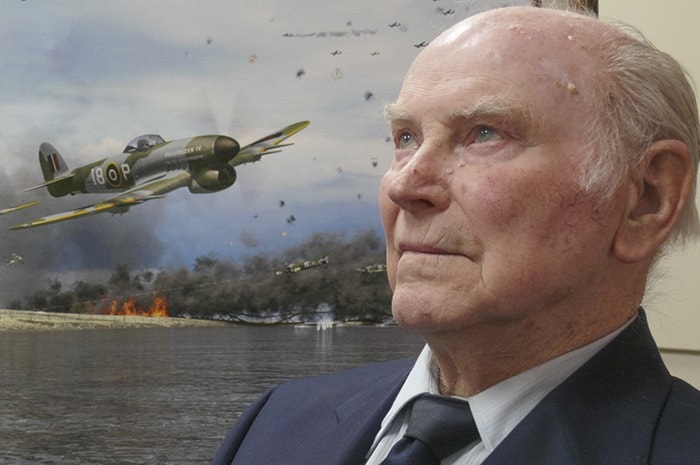Harry Hardy has a lot of stories that end with him saying that he obviously survived or he wouldn’t be here.
The 93-year-old former fighter pilot shared some of them with the Social Studies 11 class at R.E. Mountain school in Langley on Wednesday.
The students, who have been studying the history of the Second World War, listened intently as Hardy described the hazardous life of a fighter pilot of that era.
Hardy flew a Typhoon, a British-built fighter-bomber that made low-altitude attacks on German ground forces.
Flying Typhoons, by all accounts, was the most hazardous occupation for a fighter pilot during the war, with two out of three men dying in combat.
During his seven months on the front line and 96 combat missions, Hardy went through four Typhoons, all named “Pulverizer.”
It is considered the best-known Typhoon in the Royal Canadian Air Force, and the subject of several paintings by war artists.
 One photo shows how the airplane’s nose was decorated with a painting of a pretty girl, a long row of dashes to tally the number of missions and several round “flak badge” patches slapped on the holes left by German ground fire.
One photo shows how the airplane’s nose was decorated with a painting of a pretty girl, a long row of dashes to tally the number of missions and several round “flak badge” patches slapped on the holes left by German ground fire.
Hardy described losing Pulverizer II after he took on a tank during the Battle of the Bulge in 1944.
The Canadian pilots were called in to help the Americans repel the German counterattack.
“They were taking a beating,” Hardy said.
“Us Typhooners went down there to help them out.”
The way to kill a tank, he said, was to come in flat and low from behind, fire a one-second burst at the tank’s thinly armoured engine compartment with his 20 mm cannons and then, very quickly, pull up to avoid hitting the tank.
Right after attacking a tank, Hardy’s Typhoon was hit by flak and suffered substantial tail damage.
Hardy was able to keep it airborne, but realized he wouldn’t be able to land it.
“I have to leave my beautiful machine with all the nose art,” he recalled thinking.
Parachuting from a combat plane was a risky process back then, Hardy explained.
Some fighter pilots died when they bailed out because they slammed into the rear tail assembly of their own aircraft.
Hardy popped his canopy, got out carefully and slid down the wing to avoid the tail.
Hardy also described a near-crash in a U.S. Air Force (USAF) Kitty Hawk fighter during training in Canada.
“It was a purty little plane with a purty little name,” Hardy recalled.
“They (the USAF) gave ‘em to us to play with.”
Hardy was upside down at the top of a loop in his Kitty Hawk when it stalled and started to spin.
He was at 11,000 feet and the air was too thin to regain control.
By 5,000 feet, it was thicker, and he managed to get out of the inverted spin.
“That was the closest accident I almost had,” Hardy said.
He described how he discovered he was slightly cross-eyed earlier in flight training when he clipped the wing of another trainer aircraft.
It took him 17 days of intensive eye exercises to correct.
Most of his stories aimed for a humorous approach, like being forced to drop his bombs in a cow pasture because his squadron got lost and was low on gas.
“Somewhere in France, there’s two bombs, unexploded, 10 feet down (in a farm field),” Hardy said.
While Hardy is proud of his exploits as a Typhoon pilot, it was not, he admitted, his favourite.
Among other things, the torque from the 2,200 horsepower engine gave the Typhoon a tendency to pull to one side.
“It was tricky to fly, a most demanding aircraft,” Hardy said.
In response to a question from one of the students, Hardy said his favourite fighter was the legendary Spitfire.
“All you had to do was think it (a maneuver) and you’d do it,” he said.
Hardy was training as a Spitfire pilot in Britain when, with D-Day looming, he was reassigned to the Typhoons.
“We were given 20 hours of training (in the Typhoons).”
Now retired after 32 years as a mechanical engineer with MacMillan Bloedel, Hardy lives in Burnaby.
He has worked as an inventor with the Tetra Society of North America to develop devices for people with disabilities and he is well-known for his work to resurrect endangered species of exotic pheasants by breeding them in his own aviary.
